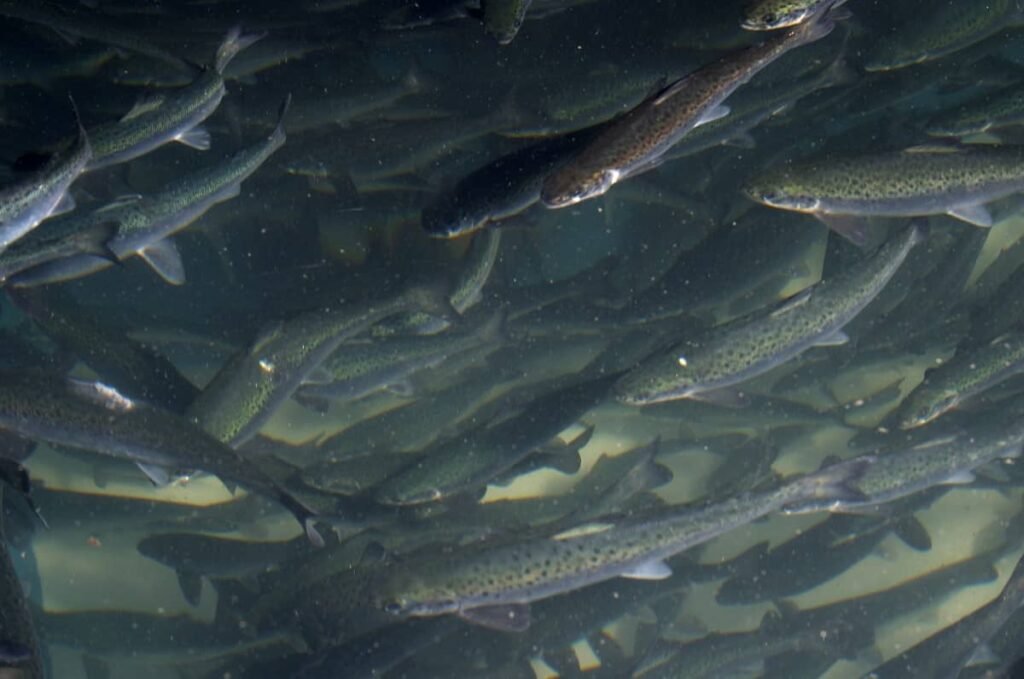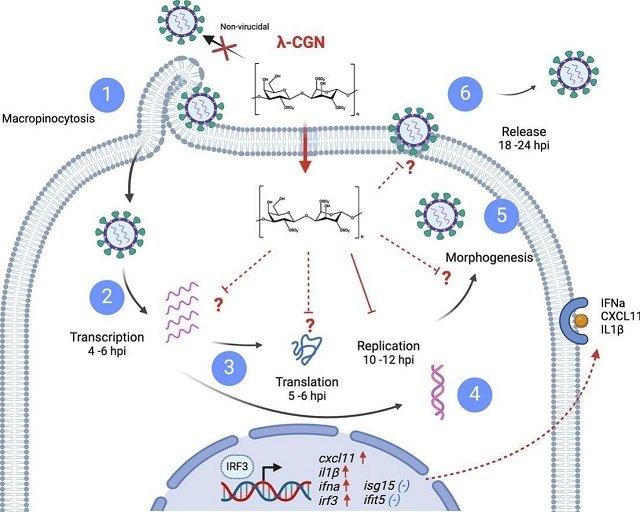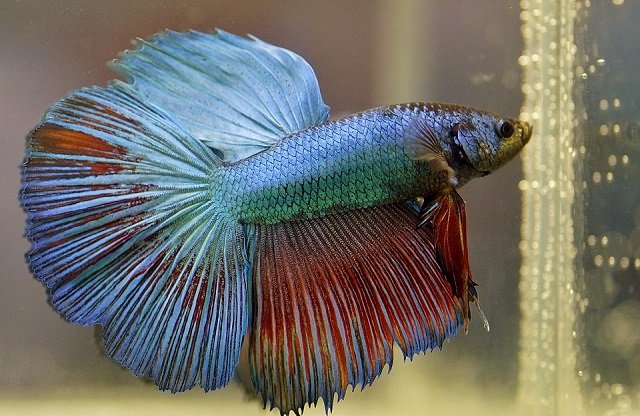
The salmon industry constantly faces health challenges, and the Infectious Pancreatic Necrosis Virus (IPNV) remains one of the most significant threats, especially for juvenile fish, where it causes high mortality rates. Although vaccines exist and various therapies are under investigation, the search for effective, safe, and natural compounds to strengthen fish defenses is a priority for the sector’s sustainability.
In this context, a recent scientific study published in Comparative Immunology Reports has focused on Alpinone, a natural flavonoid with promising antiviral capabilities. The research, led by Paz Basualto-Díaz and a team of Chilean scientists, evaluated the effects of this compound on Atlantic salmon (Salmo salar) experimentally infected with IPNV, yielding results that open a new door for health management in aquaculture.
Key Findings
- 1 Key Findings
- 2 What is Alpinone and where does it come from?
- 3 An experimental design to test Its efficacy
- 4 Fewer signs of disease and a drastic viral reduction
- 5 The secret lies in modulating the immune response in the gills
- 6 Implications for a more sustainable aquaculture
- 7 Entradas relacionadas:
- Pre-treatment with Alpinone reduced the clinical signs of disease (swollen abdomen, exophthalmia, and anorexia) in Atlantic salmon infected with IPNV.
- Alpinone led to a drastic decrease in the viral load in the fish’s kidney, showing a thousand-fold reduction compared to control groups by day 26 post-infection.
- The protective effect is associated with a more robust immune response, specifically an increased gene expression of the pro-inflammatory cytokines IL-8 and IL-12ß in the gills, 5 days after infection.
- Alpinone is emerging as a potential prophylactic immunostimulant or vaccine adjuvant to protect salmon against viral agents in aquaculture.
What is Alpinone and where does it come from?
Alpinone is a type of flavonoid, a bioactive compound found in various plants and known for its multiple biological properties, including antioxidant, anti-inflammatory, and antiviral effects. Specifically, the Alpinone used in this study was isolated and purified from the resinous exudate of the “Palo Negro” plant (Heliotropium huascoense), a shrub native to Chile’s Third Region. Previous studies had already suggested its potential as an immunostimulant and antiviral against other viruses, such as Infectious Salmon Anemia (ISAV).
An experimental design to test Its efficacy
To rigorously evaluate Alpinone’s effect, researchers from Universidad Santo Tomás, Universidad de Santiago de Chile, and Universidad de Las Américas designed a controlled experiment. They divided a total of 90 juvenile Atlantic salmon (approximately 15 grams each) into three groups:
- Alpinone Group: Received a 50 µg intramuscular injection of Alpinone.
- Montanide Group: Montanide was administered, a known adjuvant used as a reference.
- Control Group: Was injected only with a saline solution.
Thirty days after this pre-treatment, all fish were challenged with an IPNV injection. Subsequently, samples were taken at 5 and 26 days post-infection to analyze clinical signs of the disease, viral load in the anterior kidney, and the expression of key immune genes in the gills.
The study’s findings were conclusive and highly encouraging.
Fewer sick fish
Around the fifth day post-infection, when the disease typically peaks, fish in the control and Montanide groups showed clear signs associated with IPNV, such as a swollen abdomen, exophthalmia (bulging eyes), and anorexia. In contrast, the group that had been pre-treated with Alpinone showed a significantly lower incidence of these clinical signs.
The analysis of the viral load in the anterior kidney (one of the organs where IPNV replicates) revealed the most impactful finding. While the viral load was similar across all groups on day 5 post-infection, by day 26, the fish treated with Alpinone showed a viral load that was a thousand times lower than that of the fish in the control and Montanide groups. This result demonstrates a potent antiviral effect, inhibiting or helping to eliminate the virus’s replication long-term.
Stay Always Informed
Join our communities to instantly receive the most important news, reports, and analysis from the aquaculture industry.
The secret lies in modulating the immune response in the gills
How does Alpinone achieve this protective effect? The researchers sought the answer in the expression of immune genes in the gills, a mucosal tissue that is one of the primary entry points for pathogens like IPNV.
The analysis revealed that only the fish treated with Alpinone showed a significant increase in the expression of the il-8 and il-12ß genes on the fifth day post-infection. This is crucial for several reasons:
- Interleukin-8 (IL-8): This is a pro-inflammatory cytokine and chemokine that acts as an alarm signal, recruiting immune cells (like neutrophils and macrophages) to the site of infection to combat the invader. An early increase of IL-8 in the gills, as induced by Alpinone, could limit the virus’s spread from the outset.
- Interleukin-12ß (IL-12ß): This is a subunit of the IL-12 cytokine, produced by macrophages and other antigen-presenting cells, which is essential for orchestrating an effective antiviral immune response.
Interestingly, this enhanced immune response was not observed in the same manner in the Montanide-treated group, suggesting that Alpinone exerts a unique and effective immunostimulatory mechanism of action against IPNV.
Implications for a more sustainable aquaculture
The results of this study position Alpinone as a promising candidate for the development of new health strategies in salmon farming. Its ability to reduce viral load and clinical signs, mediated by the stimulation of an early and effective immune response, suggests several practical applications:
- Prophylactic treatment: It could be administered in feed preventively before high-risk periods, such as the transfer of fish to the sea.
- Vaccine adjuvant: Its immunostimulant properties could be harnessed to enhance the efficacy of existing vaccines against IPNV and other viruses.
Although more studies are needed to optimize dosage and administration routes (such as oral delivery), this work demonstrates the immense potential of natural compounds to combat diseases in aquaculture more effectively and sustainably.
Contact
Beatriz Valenzuela
Escuela Tecnología Médica, Facultad de Salud, Universidad Santo Tomás.
Viña del Mar, Chile
Email: bvalenzuela9@santotomas.cl
Reference (open access)
Basualto-Díaz, P., Benavides, A., Gutierrez, D., Epuyao, N., Modak, B., Imarai, M., & Valenzuela, B. (2025). Antiviral effects of Alpinone on Atlantic salmon (Salmo salar) infected with the Infectious Pancreatic Necrosis Virus. Comparative Immunology Reports, 200239. https://doi.org/10.1016/j.cirep.2025.200239
Editor at the digital magazine AquaHoy. He holds a degree in Aquaculture Biology from the National University of Santa (UNS) and a Master’s degree in Science and Innovation Management from the Polytechnic University of Valencia, with postgraduate diplomas in Business Innovation and Innovation Management. He possesses extensive experience in the aquaculture and fisheries sector, having led the Fisheries Innovation Unit of the National Program for Innovation in Fisheries and Aquaculture (PNIPA). He has served as a senior consultant in technology watch, an innovation project formulator and advisor, and a lecturer at UNS. He is a member of the Peruvian College of Biologists and was recognized by the World Aquaculture Society (WAS) in 2016 for his contribution to aquaculture.




